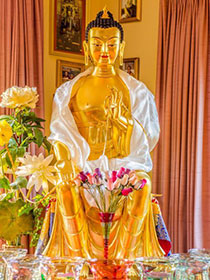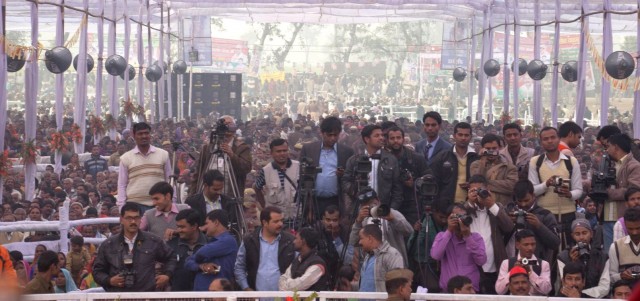- Home
- FPMT Homepage
Foundation for the Preservation of the Mahayana Tradition
The FPMT is an organization devoted to preserving and spreading Mahayana Buddhism worldwide by creating opportunities to listen, reflect, meditate, practice and actualize the unmistaken teachings of the Buddha and based on that experience spreading the Dharma to sentient beings. We provide integrated education through which people’s minds and hearts can be transformed into their highest potential for the benefit of others, inspired by an attitude of universal responsibility and service. We are committed to creating harmonious environments and helping all beings develop their full potential of infinite wisdom and compassion. Our organization is based on the Buddhist tradition of Lama Tsongkhapa of Tibet as taught to us by our founders Lama Thubten Yeshe and Lama Thubten Zopa Rinpoche.
- Willkommen
Die Stiftung zur Erhaltung der Mahayana Tradition (FPMT) ist eine Organisation, die sich weltweit für die Erhaltung und Verbreitung des Mahayana-Buddhismus einsetzt, indem sie Möglichkeiten schafft, den makellosen Lehren des Buddha zuzuhören, über sie zur reflektieren und zu meditieren und auf der Grundlage dieser Erfahrung das Dharma unter den Lebewesen zu verbreiten.
Wir bieten integrierte Schulungswege an, durch denen der Geist und das Herz der Menschen in ihr höchstes Potential verwandelt werden zum Wohl der anderen – inspiriert durch eine Haltung der universellen Verantwortung und dem Wunsch zu dienen. Wir haben uns verpflichtet, harmonische Umgebungen zu schaffen und allen Wesen zu helfen, ihr volles Potenzial unendlicher Weisheit und grenzenlosen Mitgefühls zu verwirklichen.
Unsere Organisation basiert auf der buddhistischen Tradition von Lama Tsongkhapa von Tibet, so wie sie uns von unseren Gründern Lama Thubten Yeshe und Lama Thubten Zopa Rinpoche gelehrt wird.
- Bienvenidos
La Fundación para la preservación de la tradición Mahayana (FPMT) es una organización que se dedica a preservar y difundir el budismo Mahayana en todo el mundo, creando oportunidades para escuchar, reflexionar, meditar, practicar y actualizar las enseñanzas inconfundibles de Buda y en base a esa experiencia difundir el Dharma a los seres.
Proporcionamos una educación integrada a través de la cual las mentes y los corazones de las personas se pueden transformar en su mayor potencial para el beneficio de los demás, inspirados por una actitud de responsabilidad y servicio universales. Estamos comprometidos a crear ambientes armoniosos y ayudar a todos los seres a desarrollar todo su potencial de infinita sabiduría y compasión.
Nuestra organización se basa en la tradición budista de Lama Tsongkhapa del Tíbet como nos lo enseñaron nuestros fundadores Lama Thubten Yeshe y Lama Zopa Rinpoche.
A continuación puede ver una lista de los centros y sus páginas web en su lengua preferida.
- Bienvenue
L’organisation de la FPMT a pour vocation la préservation et la diffusion du bouddhisme du mahayana dans le monde entier. Elle offre l’opportunité d’écouter, de réfléchir, de méditer, de pratiquer et de réaliser les enseignements excellents du Bouddha, pour ensuite transmettre le Dharma à tous les êtres. Nous proposons une formation intégrée grâce à laquelle le cœur et l’esprit de chacun peuvent accomplir leur potentiel le plus élevé pour le bien d’autrui, inspirés par le sens du service et une responsabilité universelle. Nous nous engageons à créer un environnement harmonieux et à aider tous les êtres à épanouir leur potentiel illimité de compassion et de sagesse. Notre organisation s’appuie sur la tradition guéloukpa de Lama Tsongkhapa du Tibet, telle qu’elle a été enseignée par nos fondateurs Lama Thoubtèn Yéshé et Lama Zopa Rinpoché.
Visitez le site de notre Editions Mahayana pour les traductions, conseils et nouvelles du Bureau international en français.
Voici une liste de centres et de leurs sites dans votre langue préférée
- Benvenuto
L’FPMT è un organizzazione il cui scopo è preservare e diffondere il Buddhismo Mahayana nel mondo, creando occasioni di ascolto, riflessione, meditazione e pratica dei perfetti insegnamenti del Buddha, al fine di attualizzare e diffondere il Dharma fra tutti gli esseri senzienti.
Offriamo un’educazione integrata, che può trasformare la mente e i cuori delle persone nel loro massimo potenziale, per il beneficio di tutti gli esseri, ispirati da un’attitudine di responsabilità universale e di servizio.
Il nostro obiettivo è quello di creare contesti armoniosi e aiutare tutti gli esseri a sviluppare in modo completo le proprie potenzialità di infinita saggezza e compassione.
La nostra organizzazione si basa sulla tradizione buddhista di Lama Tsongkhapa del Tibet, così come ci è stata insegnata dai nostri fondatori Lama Thubten Yeshe e Lama Zopa Rinpoche.
Di seguito potete trovare un elenco dei centri e dei loro siti nella lingua da voi prescelta.
- 欢迎 / 歡迎
简体中文
“护持大乘法脉基金会”( 英文简称:FPMT。全名:Foundation for the Preservation of the Mahayana Tradition) 是一个致力于护持和弘扬大乘佛法的国际佛教组织。我们提供听闻,思维,禅修,修行和实证佛陀无误教法的机会,以便让一切众生都能够享受佛法的指引和滋润。
我们全力创造和谐融洽的环境, 为人们提供解行并重的完整佛法教育,以便启发内在的环宇悲心及责任心,并开发内心所蕴藏的巨大潜能 — 无限的智慧与悲心 — 以便利益和服务一切有情。
FPMT的创办人是图腾耶喜喇嘛和喇嘛梭巴仁波切。我们所修习的是由两位上师所教导的,西藏喀巴大师的佛法传承。
繁體中文
護持大乘法脈基金會”( 英文簡稱:FPMT。全名:Found
ation for the Preservation of the Mahayana Tradition ) 是一個致力於護持和弘揚大乘佛法的國際佛教組織。我們提供聽聞, 思維,禪修,修行和實證佛陀無誤教法的機會,以便讓一切眾生都能 夠享受佛法的指引和滋潤。 我們全力創造和諧融洽的環境,
為人們提供解行並重的完整佛法教育,以便啟發內在的環宇悲心及責 任心,並開發內心所蘊藏的巨大潛能 — 無限的智慧與悲心 – – 以便利益和服務一切有情。 FPMT的創辦人是圖騰耶喜喇嘛和喇嘛梭巴仁波切。
我們所修習的是由兩位上師所教導的,西藏喀巴大師的佛法傳承。 察看道场信息:
- FPMT Homepage
- News/Media
-
- Study & Practice
-
-
- About FPMT Education Services
- Latest News
- Programs
- New to Buddhism?
- Buddhist Mind Science: Activating Your Potential
- Heart Advice for Death and Dying
- Discovering Buddhism
- Living in the Path
- Exploring Buddhism
- FPMT Basic Program
- FPMT Masters Program
- FPMT In-Depth Meditation Training
- Maitripa College
- Lotsawa Rinchen Zangpo Translator Program
- Universal Education for Compassion & Wisdom
- Online Learning Center
-
- Prayers & Practice Materials
- Overview of Prayers & Practices
- Full Catalogue of Prayers & Practice Materials
- Explore Popular Topics
- Benefiting Animals
- Chenrezig Resources
- Death & Dying Resources
- Lama Chopa (Guru Puja)
- Lama Zopa Rinpoche: Compendium of Precious Instructions
- Lama Zopa Rinpoche: Life Practice Advice
- Lama Zopa Rinpoche Practice Series
- Lamrim Resources
- Mantras
- Prayer Book Updates
- Purification Practices
- Sutras
- Thought Transformation (Lojong)
- Audio Materials
- Dharma Dates - Tibetan Calendar
- Translation Services
- Publishing Services
- Ways to Offer Support
- Prayers & Practice Materials
-
- Teachings and Advice
- Find Teachings and Advice
- Lama Zopa Rinpoche Advice Page
- Lama Zopa Rinpoche: Compendium of Precious Instructions
- Lama Zopa Rinpoche Video Teachings
- ༧སྐྱབས་རྗེ་བཟོད་པ་རིན་པོ་ཆེ་མཆོག་ནས་སྩལ་བའི་བཀའ་སློབ་བརྙན་འཕྲིན།
- Podcasts
- Lama Yeshe Wisdom Archive
- Buddhism FAQ
- Dharma for Young People
- Resources on Holy Objects
- Teachings and Advice
-
-
*If a menu item has a submenu clicking once will expand the menu clicking twice will open the page.
-
-
- Centers
-
- Teachers
-
- Projects
-
-
-
-
*If a menu item has a submenu clicking once will expand the menu clicking twice will open the page.
-
-
- FPMT
-
- Shop
-
-
-
The Foundation Store is FPMT’s online shop and features a vast selection of Buddhist study and practice materials written or recommended by our lineage gurus. These items include homestudy programs, prayers and practices in PDF or eBook format, materials for children, and other resources to support practitioners.
Items displayed in the shop are made available for Dharma practice and educational purposes, and never for the purpose of profiting from their sale. Please read FPMT Foundation Store Policy Regarding Dharma Items for more information.
-
-
20
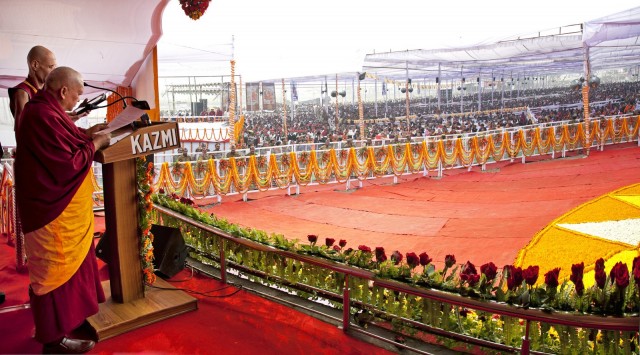
Lama Zopa Rinpoche during speech, Maitreya Project trustee Ven. Kabir Saxena interpreting into Hindi, Kushinagar, India, December 13, 2013. Photo by Andy Melnic.
On December 13, 2013, the state government of Uttar Pradesh, India, handed over approximately 275 acres of land to the Maitreya Project, the FPMT Project to build an enormous bronze statue of Matireya Buddha. At the ceremony marking the historic land transfer and the laying of the foundation stone, FPMT Spiritual Director Lama Zopa Rinpoche offered the following speech to gathered dignitaries, including Uttar Pradesh Chief Minister Akhilesh Yadav, and an audience of 100,000.
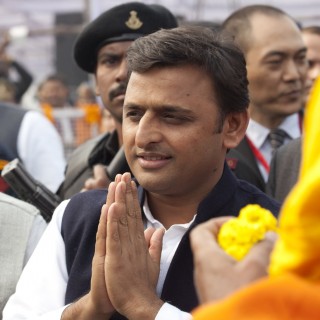
Uttar Pradesh Chief Minister Akhilesh Yadav, Kushinagar, India, December 13, 2013. Photo by Andy Melnic.
I am thanking from my heart His Excellency the Honorable Chief Minister, the Chief Secretary, the Ministers for Culture, Tourism, Home Guard and Professional Education and the rest of the compassionate leaders who are attending the Maitreya Project celebration in Kushinagar and bringing peace and happiness to this world, and especially to India.
My heartfelt thanks to the Uttar Pradesh government for giving Maitreya Project the land and to all the farmers who offered their land for the Maitreya Project to bring not just peace and happiness, but ultimate happiness, with total cessation of the oceans of samsaric suffering—the sufferings of rebirth, old age, sickness, death and so forth; second, samsaric pleasures, that which are suffering; and the foundation of those sufferings, pervasive, compounding suffering—and full enlightenment, the complete cessation of even the subtle obscurations and the completion of all realizations, to the six types of numberless living beings, especially in this world, and especially in India.
The Maitreya Project came to be in Kushinagar when we had great difficulties in obtaining land for the Maitreya statue in Bodhgaya for such a long time. I requested His Holiness the Dalai Lama for advice, and His Holiness requested in front of the Buddha statue in the Bodhgaya Stupa [Mahabodhi Temple] and the answer came out Kushinagar. The evolution is that Kushinagar came from Buddha and His Holiness.
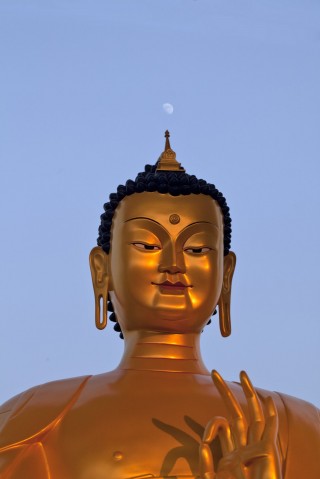
A photo of a life-sized replica of the Maitreya Buddha statue to be built in Kushinagar, India, December 12, 2013. Photo by Andy Melnic.
In regard to the purpose of the Maitreya Project, there are general benefits and particular benefits in this world. The general benefits are that Maitreya Buddha will be the fifth founder of Buddhadharma, the next after Shakyamuni Buddha, who will descend in this world also in India and perform the 12 holy deeds, as Shakyamuni Buddha did. I discovered in a teaching from His Holiness the Dalai Lama’s guru that Kushinagar will be the place where Maitreya Buddha will be born. I thought it very auspicious that Maitreya Buddha will show the holy deed of taking birth in Kushinagar.
Building this statue of Maitreya Buddha, Loving Buddha, will bring loving kindness to the hearts of everyone in this world, and especially to India.
Not only the organization working for this statue, but all the people who offered the land and who work on building the statue will become the first disciples of Maitreya Buddha, will receive teachings from Maitreya Buddha and will also receive the prediction of their enlightenment.
In regard to the particular benefits, in the near future the whole world will be full of wars, with so many people being killed; there will be famine all over the world, with so many people dying; and there will be sicknesses everywhere in the world, with so many people dying. The more Maitreya Buddha statues that are built, the more this suffering will be decreased and able to be stopped. This is a very, very important reason.
Therefore, I would like to thank very much the Uttar Pradesh government and the farmers of Kushinagar.
The Tibetan Buddhism that Tibetan lamas studied, practiced and actualized, with incredible numbers becoming bodhisattvas and buddhas, has now spread almost all over the world in a way that never happened before. In the USA, Australia and some other countries, the fastest growing religion is Buddha’s teachings, which were taught in India by Shakyamuni Buddha and also by the Indian pandits, the Six Ornaments (Nagarjuna, Aryadeva, Asanga, Vasubandhu, Dignaga and Dharmakirti) and the Two Supreme Disciples (Gunaprabha and Shakyaprabha), whose paintings are here around the people, on the right and left sides. These great Indian pandits wrote commentaries to Buddha’s teachings, such as the five great treatises of sutra: Pramanavartika (the science of mind that logically proves reincarnation, karma, that Buddha is pure and reliable as well as his teachings and so forth), Abhisamaya-alamkarika (which shows how to develop compassion to all living beings, that which is the source of peace and happiness, enlightenment and the details of the path to enlightenment and the qualities of Buddha), Madhyamaka (study of the two truths: the whole of existence is embodied in the two truths; the ultimate wisdom of shunyata can totally eradicate the root of the suffering of samsara, the ignorance), Abhidharmkosha (details of the mind and mental factors, the evolution of the world and so forth) and Vinaya (the morality, or ethics, to achieve rebirth as a human being or deva; the monks’ and nuns’ discipline, which is the basis to achieve the higher training of concentration and the higher training of wisdom, to achieve liberation from samsara and full enlightenment, the omniscient mind, the peerless happiness, for sentient beings.
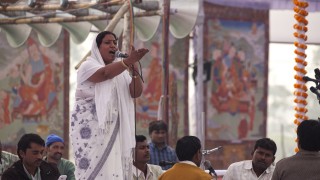
Cultural performance in front of thangkas brought from Kopan Monastery, Kushinagar, India, December 13, 2013. Photo by Andy Melnic.
Then there were many other great pandits and many great meditators in Tibet from the four Mahayana traditions: Nyingma, Kagyü, Sakya and Gelug. There were Padmasambhava; Gyalwa Longchenpa; the five great Sakya lamas, including Sakya Pandita; Marpa and Milarepa; Lama Tsongkhapa; and so forth, who wrote many commentaries to what Buddha had explained. So, like this, Tibetan Buddhism came from India. There’s no other separate Buddhism that Tibetan lamas practice that didn’t come from India. Shantarakshita, Lama Atisha and so forth brought Buddhism from India to Tibet, so everyone must know that which was being taught in India by Shakyamuni Buddha and what the fully distinguished Indian pandits taught, the knowledge of Buddha, wide and deep like the Pacific Ocean, in the great Buddhist university of Nalanda, which had 300 pandits (and there was also Vikramashila) has not been degenerated. In Tibet these have been the main teachings, the main practice and the main path to actualize, so it has flourished in Tibet, even though it was stopped after Mao Zedong took over Tibet.
Now, mainly because His Holiness the Dalai Lama was able to come to India, along with some learned lamas, Buddhism is able to flourish so much in India. It is a good time to offer the knowledge, and not just intellectual understanding, but the experience of realization, back to the Arya Mother Land, India, and to the Indian people. It can be returned by learning and by realizing the Buddha’s teachings.
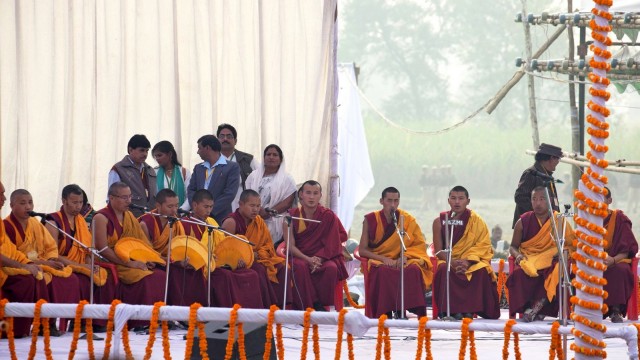
Monks from Kopan Monastery chanting the Heart Sutra, Kushinagar, India, December 13, 2013. Photo by Andy Melnic.
Buddhism has not only spread all over the West, but even top scientists are finding it very scientific and that they have much to learn from Buddhism. So, this is basically Indian Buddhism. You must rejoice and appreciate that this Buddhism is what came from India.
In regard to helping the Kushinagar community, I would really like to begin by offering medical services, and then assess whatever other needs the community has. My heart is there. Building the statue is also a social service. So many hundreds, or thousands, of people will find jobs so that they can look after their families and send their children to school.
Please pray for the success of the Maitreya Project. I hope we meet again when the statue is up. Thank you very much. Please, everyone, enjoy the celebration. Thank you very much from my heart to the monks who did the dances and prayers, the performers and everyone else who worked so hard for this function.
Colophon: Lama Zopa Rinopche speaking at historic foundation stone laying ceremony for the Maitreya Project in Kushinagar, India, December 13, 2013. Lightly edited Ven. Ailsa Cameron.
For more, read Ven. Thubten Labdron’s report and Ven. Gyalten Samten’s reflections on arranging the foundation stone laying ceremony in five days.
Mandala’s ongoing coverage of the Maitreya Project can be read online.
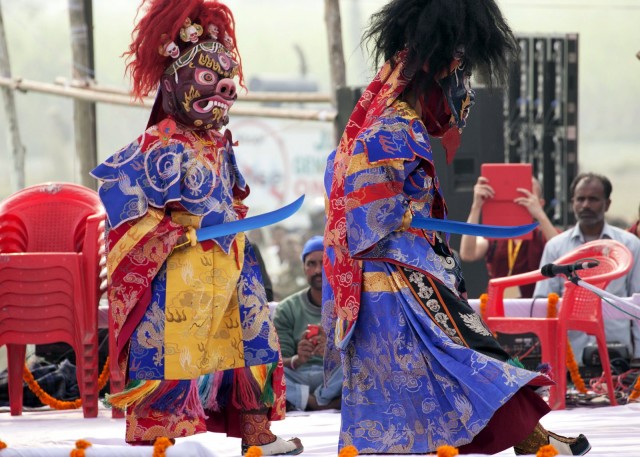
Dancers doing traditional Tibetan dance, Kushinagar, India, December 13, 2013. Photo by Andy Melnic.
Mandala brings you news of Lama Zopa Rinpoche and of activities, teachings and events from over 160 FPMT centers, projects and services around the globe. If you like what you read on Mandala, consider becoming a Friend of FPMT, which supports our work.
- Home
- News/Media
- Study & Practice
- About FPMT Education Services
- Latest News
- Programs
- New to Buddhism?
- Buddhist Mind Science: Activating Your Potential
- Heart Advice for Death and Dying
- Discovering Buddhism
- Living in the Path
- Exploring Buddhism
- FPMT Basic Program
- FPMT Masters Program
- FPMT In-Depth Meditation Training
- Maitripa College
- Lotsawa Rinchen Zangpo Translator Program
- Universal Education for Compassion & Wisdom
- Online Learning Center
- Prayers & Practice Materials
- Overview of Prayers & Practices
- Full Catalogue of Prayers & Practice Materials
- Explore Popular Topics
- Benefiting Animals
- Chenrezig Resources
- Death & Dying Resources
- Lama Chopa (Guru Puja)
- Lama Zopa Rinpoche: Compendium of Precious Instructions
- Lama Zopa Rinpoche: Life Practice Advice
- Lama Zopa Rinpoche Practice Series
- Lamrim Resources
- Mantras
- Prayer Book Updates
- Purification Practices
- Sutras
- Thought Transformation (Lojong)
- Audio Materials
- Dharma Dates – Tibetan Calendar
- Translation Services
- Publishing Services
- Teachings and Advice
- Find Teachings and Advice
- Lama Zopa Rinpoche Advice Page
- Lama Zopa Rinpoche: Compendium of Precious Instructions
- Lama Zopa Rinpoche Video Teachings
- ༧སྐྱབས་རྗེ་བཟོད་པ་རིན་པོ་ཆེ་མཆོག་ནས་སྩལ་བའི་བཀའ་སློབ་བརྙན་འཕྲིན།
- Podcasts
- Lama Yeshe Wisdom Archive
- Buddhism FAQ
- Dharma for Young People
- Resources on Holy Objects
- Ways to Offer Support
- Centers
- Affiliates Area
- Teachers
- Projects
- Charitable Projects
- Make a Donation
- Applying for Grants
- News about Projects
- Other Projects within FPMT
- Support International Office
- Projects Photo Galleries
- Give Where Most Needed
- FPMT
- Shop
Subscribe to FPMT News
Translate*
*powered by Google TranslateTranslation of pages on fpmt.org is performed by Google Translate, a third party service which FPMT has no control over. The service provides automated computer translations that are only an approximation of the websites' original content. The translations should not be considered exact and only used as a rough guide.The purpose of meditation is not to reach nirvana and then disappear. If that was the case, it would better that you manifested as a flower!







